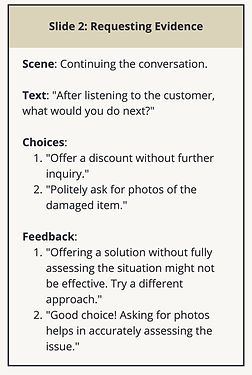Scenario | 5-10 minute read
Handling Furniture Returns through Smarter Conversations

00
Key Points
-
Course designed for Customer Service Representatives (CSRs) to learn communication techniques that offer viable options to the customer and help reduce company costs
-
Created a 20-minute course (self-paced video and scenarios) and implemented it into the CSR onboarding program
-
Post-course: quarterly report states ~6% decrease in overall furniture returns. Survey shows 40% of participants found the course to be informative and entertaining. 60% of CSRs intend to apply at least one technique on-the-job
01
Overview
Role
In this exciting project, I was the Lead Instructional Designer. I worked closely with a content developer to create audio recordings and visual assets. My initiative was to create an engaging, interactive course tailored for our customer service representatives (CSRs).
Responsibilities
The project involved working closely with the Subject Matter Expert (SME), crafting a compelling script, building clickable prototypes, and finally, bringing everything to life using Articulate Storyline 360.
Tools
Adobe XD, Articulate Storyline 360 and Rise
Stakeholders
-
Director of Customer Service
-
Transportation Specialist (Subject Matter Expert)
-
Senior Learning and Development Manager
End-Users / Learners
-
Customer Service Representatives (CSR)
Sharing rights of my deliverables... ✔︎ Prototype x Articulate Storyline & Rise course
02
Situation
There's been panic at the warehouse... Furniture returns are stacking up from floor to ceiling!
During my discovery interview with the Logistics specialist at the warehouse, I learned...
while returns are acceptable, per company policy, not all returns are necessary. Excessive returns overwork employees and weaken the company's bottom line.

03
Problem
CSRs are too quick to initiate furniture returns, resulting in excessive costs and a burden on the employees. After multiple SME interviews, I learned that the transportation department knows of a simple and effective way of handling furniture returns, but it is not being taught by CSRs, those who are issuing the returns.
Each day, we are loosing 10s of thousands
of dollars and burdening our employees
by accepting all furniture returns.
"
- Senior Logistics Specialist
04
Action Map
After multiple revisions with managers and SMEs, I finalized this action map that outlines what CSRs need to know (concept) and do (approach) in order to achieve the organization's desired goal.

Rationale: During a 30-minute meeting with the Customer Service Lead, I discovered that customer service representatives (CSRs) are mistakenly issuing returns on non-returnable items, such as clearance goods. This highlights the need for CSRs to fully grasp the returns policy.
05
Solution
Selected Design
After evaluating several prototypes with my design team, we chose to create a course that consists of a self-paced video and scenario-based activity. This course was primarily integrated in the first two week of CSR’s onboarding cycle.
-
Self-paced video offered CSRs to learn the return-handling process at their own pace.
-
Scenarios offered an opportunity to practice what they learned, improving the transfer of learning.
-
Pre-post course survey was administered to monitor progress, offered timely feedback to the CSRs, instructors, and designers, and lent opportunities for course modification for future cohorts.
Text-based storyboards for scenarios (samples)



Wireframe for branching scenarios on mobile (designed on Adobe XD)

06
Working Prototype
This design is mobile-ready. CSRs can expect to take this scenario-based activity at their desk, sales floor or in the warehouse. Click below to start!

07
Results

The warehouse workers finally found the relief they so very well deserve. Thanks to the CSRs!
Quarterly reports showed an 6% decrease in furniture returns within 3 months of the message being championed and delivery of the course.
Pre-post course surveys revealed that the course resonated well with the CSRs as 60% stated that they would apply the learned techniques on-the-job. 40% of participants found the course to be informative and entertaining.
Facilitators plan to utilize surveys to evaluate the ongoing effectiveness of the course in the onboarding program.
Other Selected Works
High-potentials leverage simple, yet effective coaching techniques through this Coaching Program to transform the way they lead.
Students gain access to tutors and collaboration tools through this on-demand tutoring platform when instructors are not available.

